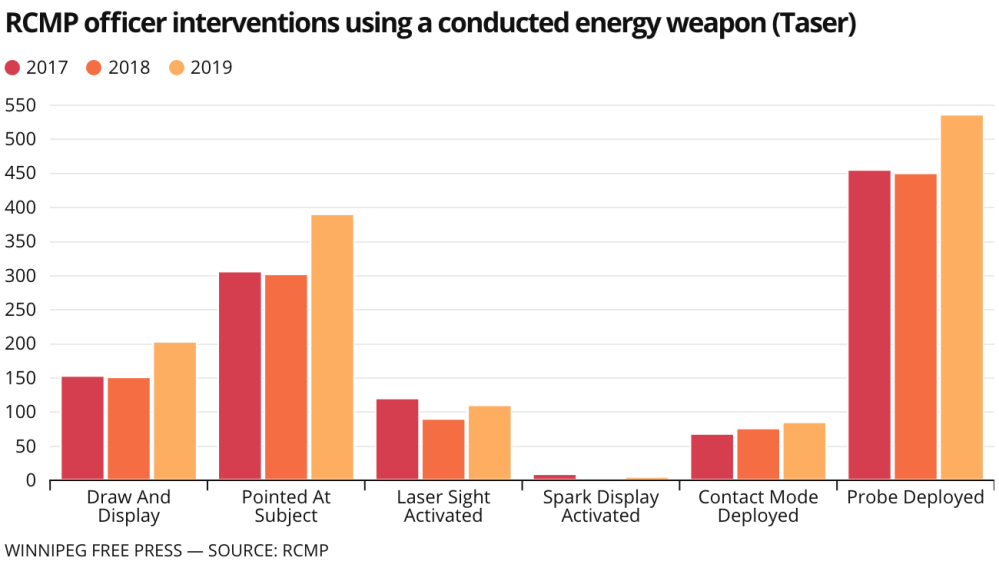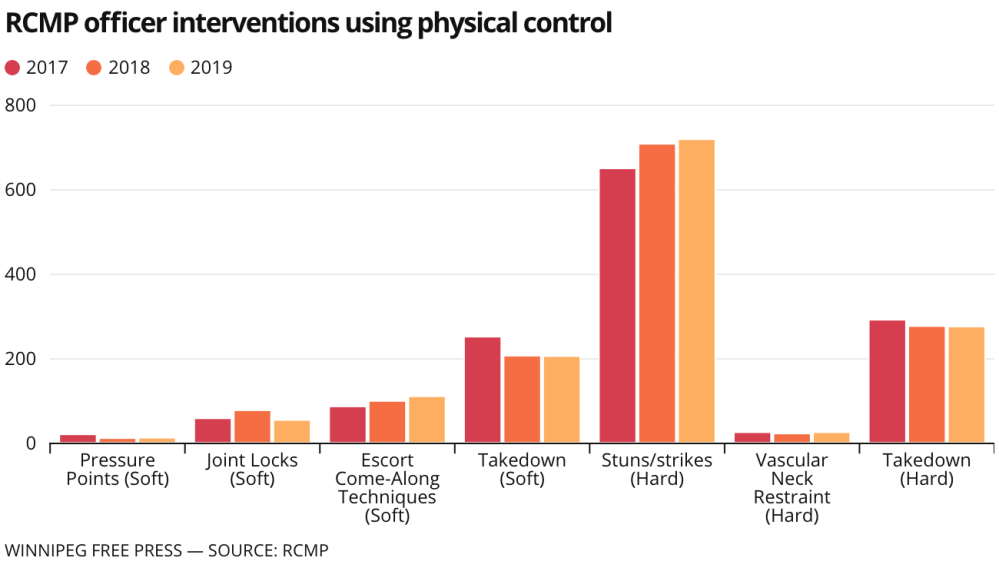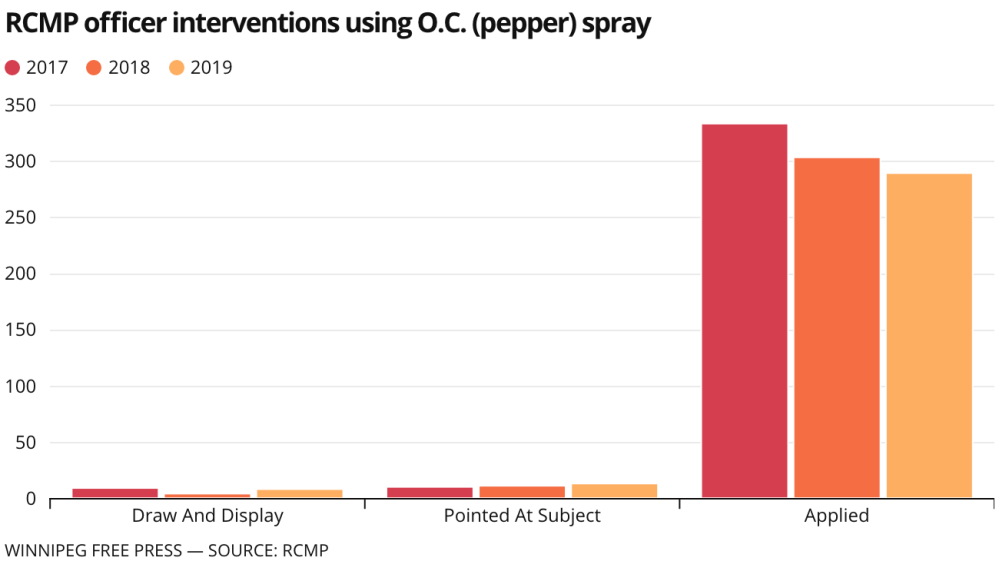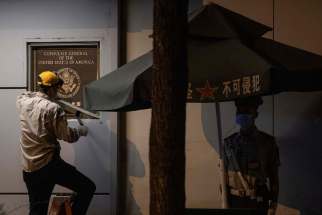RCMP use-of-force numbers slightly decline, firearm usage steadily drops
Read this article for free:
or
Already have an account? Log in here »
To continue reading, please subscribe:
Monthly Digital Subscription
$0 for the first 4 weeks*
- Enjoy unlimited reading on winnipegfreepress.com
- Read the E-Edition, our digital replica newspaper
- Access News Break, our award-winning app
- Play interactive puzzles
*No charge for 4 weeks then price increases to the regular rate of $19.00 plus GST every four weeks. Offer available to new and qualified returning subscribers only. Cancel any time.
Monthly Digital Subscription
$4.75/week*
- Enjoy unlimited reading on winnipegfreepress.com
- Read the E-Edition, our digital replica newspaper
- Access News Break, our award-winning app
- Play interactive puzzles
*Billed as $19 plus GST every four weeks. Cancel any time.
To continue reading, please subscribe:
Add Free Press access to your Brandon Sun subscription for only an additional
$1 for the first 4 weeks*
*Your next subscription payment will increase by $1.00 and you will be charged $16.99 plus GST for four weeks. After four weeks, your payment will increase to $23.99 plus GST every four weeks.
Read unlimited articles for free today:
or
Already have an account? Log in here »
Hey there, time traveller!
This article was published 28/07/2020 (1950 days ago), so information in it may no longer be current.
OTTAWA — Manitoba RCMP are pulling out their guns less, and instead reaching for their stun guns.
Internal use-of-force statistics obtained by the Free Press show Manitoba officers deployed Tasers 154 times between 2017 and 2019, a three-year stretch in which police firearm use steadily declined.
“The RCMP are sensitive now to the issues around the use of force,” University of Winnipeg criminal-justice professor Michael Weinrath said. “As always, the devil’s in the details, in trying to determine if (things) are getting better.”
While national data show an uptick in Mounties using force, the number of those incidents slightly declined in Manitoba over the three-year period.
For example, Manitoba RCMP pointed their guns at people 269 times in 2017, 175 times in 2018 and 156 times in 2019. Nationally, officers aimed their guns at people more frequently each of those years.
Manitoba RCMP deployed Tasers 50 times in 2017, 36 in 2018 and 68 times last year.
Over the three-year period, Mounties struck or hit Manitobans 244 times, with a slight uptick in 2019. Pepper spray was used 73 times and police dogs bit people in 10 incidents, though RCMP logged a gradual decline in both practices.
Manitoba RCMP shot an “extended range impact weapon,” which resembles an assault rifle but shoots plastic-covered sponge projectiles, in three incidents over the past three years, and also displayed the weapon to suspects six times. Elsewhere, RCMP have increased their use of this weapon.
Last month, the Winnipeg Police Service filed its own use-of-force data for 2015 to 2019, which showed a sustained uptick in Taser use, with a 73 per cent jump in 2019 in how often they deployed probes, which incapacitate people from moving.
Neither the RCMP nor Winnipeg police publish data on the ethnicity of people subject to the various uses of forces. Both require officers report the use of any force.

The two data sets suggest Winnipeg police calls are 4.5 times more likely to involve the use of force than Manitoba RCMP calls.
Weinrath noted Manitoba experiences far more violent crime than most of the country, and that shapes how police respond.
He said an increase in Taser usage and other practices such as pepper spray could suggest a move away from lethal force, but only if police are fully complying in reporting incidents.
Meanwhile, Manitoba RCMP officers reported using a “vascular neck restraint” three times in 2019, and just once in each of the two previous years. Nationally, RCMP have used this method 72 times, but the force is reviewing its practice as it can contribute to heart attack or strokes.
The RCMP insist that the practice is not a chokehold as it is not meant to obstruct the windpipe, though critics say it’s still far too risky.
In May, Minneapolis police sparked protests across the continent after killing George Floyd, an unarmed Black man, by kneeling on his neck during an arrest. A 2014 wave of protests started after New York City police held Eric Garner in a chokehold, during which he pleaded “I can’t breathe,” which became a rallying cry after his death.
The Mounties stressed the proportion of calls involving force has gone down over the past decade, with 99.9 per cent handled either through communication, or by physically controlling someone without injuring them.

“Incidents involving police intervention are complex, dynamic and constantly evolving, often times in a highly-charged atmosphere,” Cpl. Caroline Duval wrote in an emailed statement.
“Through crisis intervention and de-escalation techniques, many mental-health crisis situations can be managed with decreased risk to the public and police officers.”
In any case, Weinrath said he was encouraged by the RCMP releasing its data.
“There’s a message to the public, and to the (RCMP) members that ‘we’re tracking this stuff and we’re serious about acting to reduce the use of these excessive-force measures.'”
The RCMP police nearly every Manitoba municipality outside Winnipeg and Brandon. In the surveyed period, a rise in violent and property crimes across the Prairies has sparked parliamentary hearings and a revision of the model that funds the Mounties.
The force has come under more scrutiny over the deaths of people in mental-health distress and brutality against Indigenous people caught on film, such as an Alberta chief being body slammed and an Inuit man being hit with a car door.
Last month, Manitoba’s federal cabinet minister Dan Vandal pushed his government to help change how rural and city police interact with Indigenous people.

“The images we saw of police brutality are absolutely unacceptable and we need to stop the hate,” said the MP for St. Boniface-St. Vital, who is Métis.
The Liberals have considered making body cameras mandatory for police officers, though advocates have questioned whether that would improve police behaviour.
dylan.robertson@freepress.mb.ca
RCMP use-of-force data: Manitoba followed by national statistics







